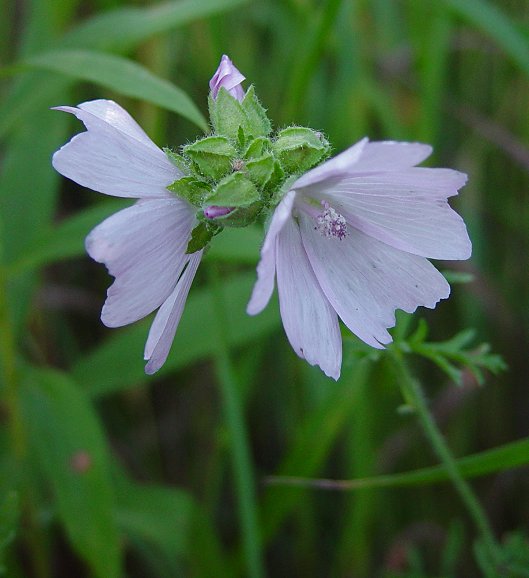Malva moschata L.
Musk Mallow

Introduced
CC = *
CW = 5
MOC = 2
© DETenaglia
Malva moschata L.Musk Mallow | |
 |
Introduced CC = * CW = 5 MOC = 2 |
© DETenaglia |
|
Family - Malvaceae Stems - Herbaceous, erect, branching, from a woody caudex, to 1m tall, pilose, scabrous due to pustulate bases of trichomes, glaucous. Trichomes often with purplish bases.
Leaves - Alternate, petiolate, stipulate. Stipules entire, subulate, +/-6mm long, 2-3mm broad. Petioles with an adaxial groove, pubescent. The trichomes of the petioles sometimes forked and with purple bases. Leaf blades 3-5 lobed, ovate to orbicular in outline, +6cm long, 5-6cm broad, sparse pubescent adaxially, stellate pubescent abaxially. Lobes deeply dissected or not. Ultimate divisions of divided lobes ~2mm broad, acute.
Inflorescence - Terminal bracteate umbellate cluster of 2-7 flowers. Bracts reduced, foliaceous. Pedicels 8-10mm long, with forked long pubescence. Calyx closely subtended by 3 linear-lanceolate bracts. Bracts 5-7mm long, 1-2mm broad, pubescent as the calyx. Flowers - Petals 5, white to blue, glabrous, united at the base and forming the staminal column. Petals truncate to emarginate at the apex, 2-2.5cm long, +/-2cm broad. Staminal column 8mm long, glandular pubescent. Anthers +/-50, white to pink, -1mm broad. Styles +/-15, surrounded by staminal column. Free portion of styles pinkish-purple, -1cm long, compressed and dorsally pubescent. Ovary 15 carpellate. Carpels green, with a floccose tuft of hairs at the apex in flower. Each individual carpel ~1mm long. Calyx densely tomentose internally, 5-lobed. Calyx tube 4-5mm long, stellate (forked) pubescent. Lobes 7-8mm long, acute, triangular.
Flowering - May - October. Habitat - Waste places, cultivated ground, disturbed sites. Often cultivated. Origin - Native to Europe. Other info. - This introduced species is uncommon in the wilds of Missouri but is commonly cultivated. The flower color of the species is variable, ranging from pure white to pink or blue. The leaves of this species can be variable also. The form found most commonly is form laciniata (Desr.) Hayek, which has finely dissected leaves. This form is shown above. Form heterophylla (Vis.) Hayek, has only the uppermost leaves dissected. Form moschata has leaves which are simply lobed and undivided. Photographs taken at Pictured Rocks National Seashore, MI., 7-23-02. |